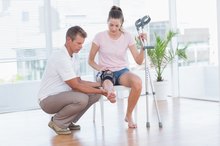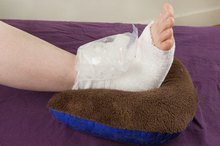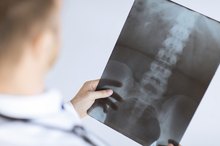What Are the Treatments for Hip Pain After a Fall?
Every year, one out of three adults over the age of 65 fall, according to the Centers for Disease Control 1. Injuries from a fall can range from very mild to broken bones. A hip fracture resulting from a fall is a very serious medical emergency. Fortunately, not all falls are severe enough to break a hip bone. These falls may only cause bruising and swelling of the hip, along with some pain and stiffness. Injuries to the muscle and tendons can also cause discomfort. These symptoms can be treated at home without the care of a physician.
If you are experiencing serious medical symptoms, seek emergency treatment immediately.
Rest
The patient should get as much rest as possible. The body needs time to heal. He should avoid bearing weight on the wounded hip. A cane, walker or crutches should be used to aide in walking.
- The patient should get as much rest as possible.
- He should avoid bearing weight on the wounded hip.
Ice
How to Care for a Bruised Knee
Learn More
Ice can reduce pain and swelling after a fall. The individual should apply ice, a cold washcloth or a commercial ice pack that has been stored in a freezer on the affected site. Ice or an ice pack should never be placed directly on the skin; a towel or washcloth should be used to protect the skin.
Compression
The patient should apply pressure to the hip to reduce pain and swelling. She can hold a small pillow tightly against the affected area. Normally, a tight bandage is applied to injuries because compression helps reduce inflammation, but applying a compression dressing to the hip is very difficult.
Elevation
How to Lift a Fallen Patient
Learn More
The person who fell should lay on the non-affected hip to keep the painful hip elevated. This will ease discomfort and inflammation by reducing pressure on the injury and allowing any excess fluids to drain away. He should put a pillow between his legs to align the leg properly, which then reduces stress on the hip joint. A nurse or family member can prop a pillow behind his back if it is difficult for him to lie on his side.
- The person who fell should lay on the non-affected hip to keep the painful hip elevated.
Pain Relievers
Pain relievers can reduce discomfort. Non-steroidal anti-inflammatory medicine like ibuprofen can alleviate pain as well as shrink swelling. A doctor may prescribe stronger pain relievers.
Increase Activity
The patient should gradually increase physical activity as tolerated. A physical therapist can teach the patient exercises to strengthen her hip muscles and advise her on how quickly she should advance her activities. Swimming is sometimes recommended because it allows strengthening and stretching of the muscles without straining the hip.
Medical Treatment
If there is physical deformity of the hip, or if the patient cannot bear weight on his leg, immediate medical attention must be sought. If pain is not resolved in seven to 10 days, an appointment with a physician should be made. X-rays will be taken of the hip, and surgery may be performed.
Related Articles
References
Writer Bio
Lynn Hetzler has been a writer since 2000. She was editor in chief and head writer for the online publication Eye on Cameraware. She owns a computer store offering repair, websites, instruction, and more. Hetzler is a certified medical assistant with experience in oncology, laboratory testing and protocol writing.








